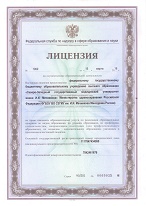North-Western State Medical University named after I.I. Mechnikov (NWSMU)
|
The idea of establishing the Institute belonged to famous 19th century medical professors: N. I. Pirogov, N. F. Zdekauer and the first director of the Institute, E. E. Eichwald. On June 3, 1885, a grand project for the establishment of the first Russian Institute of Advanced Medical Studies was carried out with the blessing of the Romanovs, and particularly Grand Duchess Yelena Pavlovna. The Imperial Clinical Institute was known for its eminent scientists and doctors who worked there in those years: directors Prof. E. E. Eichwald, and Prof. M. I. Afanas'ev, Prof. N. V. Sklifosovsky and Prof. G. F. Tiling, Prof. D. A. Ott, Prof. N. D. Monastyrsky, Prof. O. O. Mochutkovsky, Prof. A. K . Limberg, Prof. D. A. Romanovsky, Prof. N. A. Mikhailov, Prof. G. V. Khlopin and others. |
 |
|
After 1917 activities of the Clinical Institute go to the state framework, and training becomes mandatory. In 1924 it was renamed “the Leningrad Institute of advanced medical studies (GIDUV), and in 1993 it was reorganizes into the Medical Academy of Postgraduate Studies (MAPS). Currently, the Academy is one of the leading universities in Russia in the system of advanced medical studies. In 2011, St. Petersburg Medical Academy of Postgraduate Education (SPbMAPO) and St. Petersburg State Medical Academy n. a. I. I. Mechnikov were merged (SPbGMA). SPbGMA has a history of more than 100-years. In 1907 academician V. M. Bekhterev created a Psychoneurological Institute, which had three departments: medical, legal and pedagogical. In 1920, the medical department was transformed into an independent university - the State Institute of Medical Knowledge. It changed its name for several times during the whole period of its existence. In 1930, it was renamed the 2-nd Leningrad Medical Institute, in 1947 it was called the Leningrad Sanitary and Hygienic Medical Institute (LSGMI), and in 1994 it received the status of an academy and became known as St. Petersburg State Medical Academy n. a. I. I. Mechnikov. As a result of the merger of these two largest medical educational institutions, the North-West State Medical University n. a. I. I. Mechnikov was established. |
|
St Petersburg University (SPbU)
|
St Petersburg University was founded by Peter I as part of an integrated system of science and education in Russia, which included the Academy of Sciences, the university and gymnasium. Among the first university professors have been great scientists: mathematicians L. Euler, D. Bernoulli, historian G. Z. Bayer. The first rectors were a well-known historian and ethnographer, Academician G.F. Miller, an outstanding scientist and traveler, S.P. Krasheninikov, and from 1758 to 1765. St Petersburg University was headed by the great Russian scientist Mikhail Lomonosov lexicographer, who in 1747 began reading the first course of physics in Russian. Since 1760-ies University and high school were located in the house of Baron Stroganov on the arrow Vasilevsky Island. |
 |
|
Over 295 years of existence, St Petersburg University has obtained the right to be called one of the best universities in Russia. It has rich historical past, modern research, the active development and innovation and it’s placed in the forefront of Russian science. Faculty of Medicine is one of the youngest faculties of the University. The need to create this Faculty was obvious even to Peter I. However, the opening of faculty held after 274 years. Despite this, for its 15-year history the Medical Faculty of St. Petersburg State University has formed a strong teaching staff and set a task - to form the 21 st century physician. |
|
St Petersburg University today has:
Official internet site of SPbU |
 |
